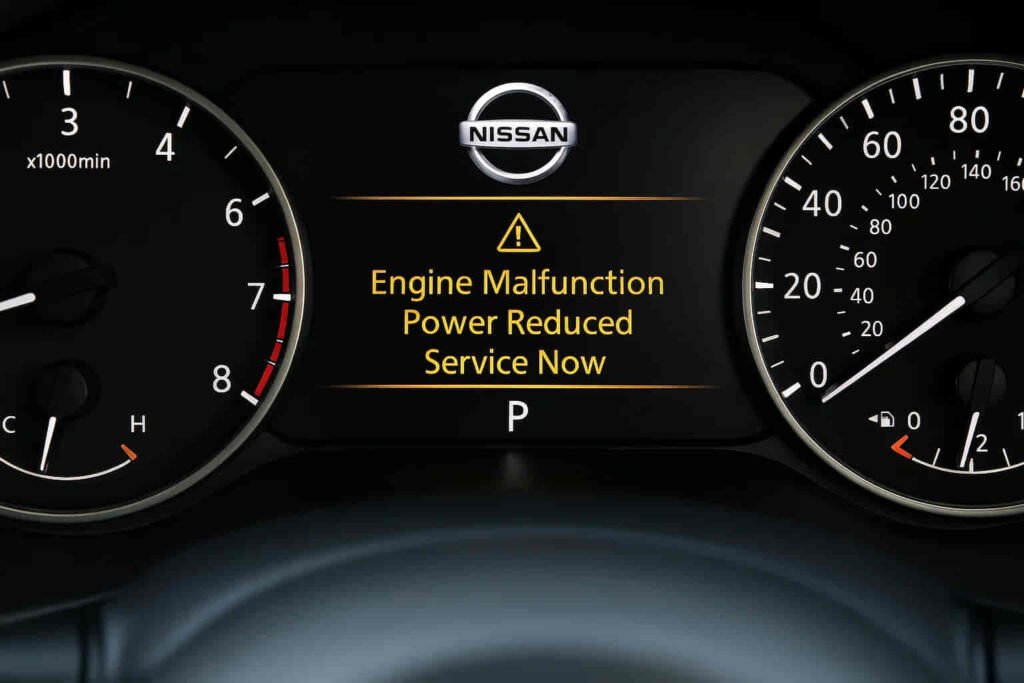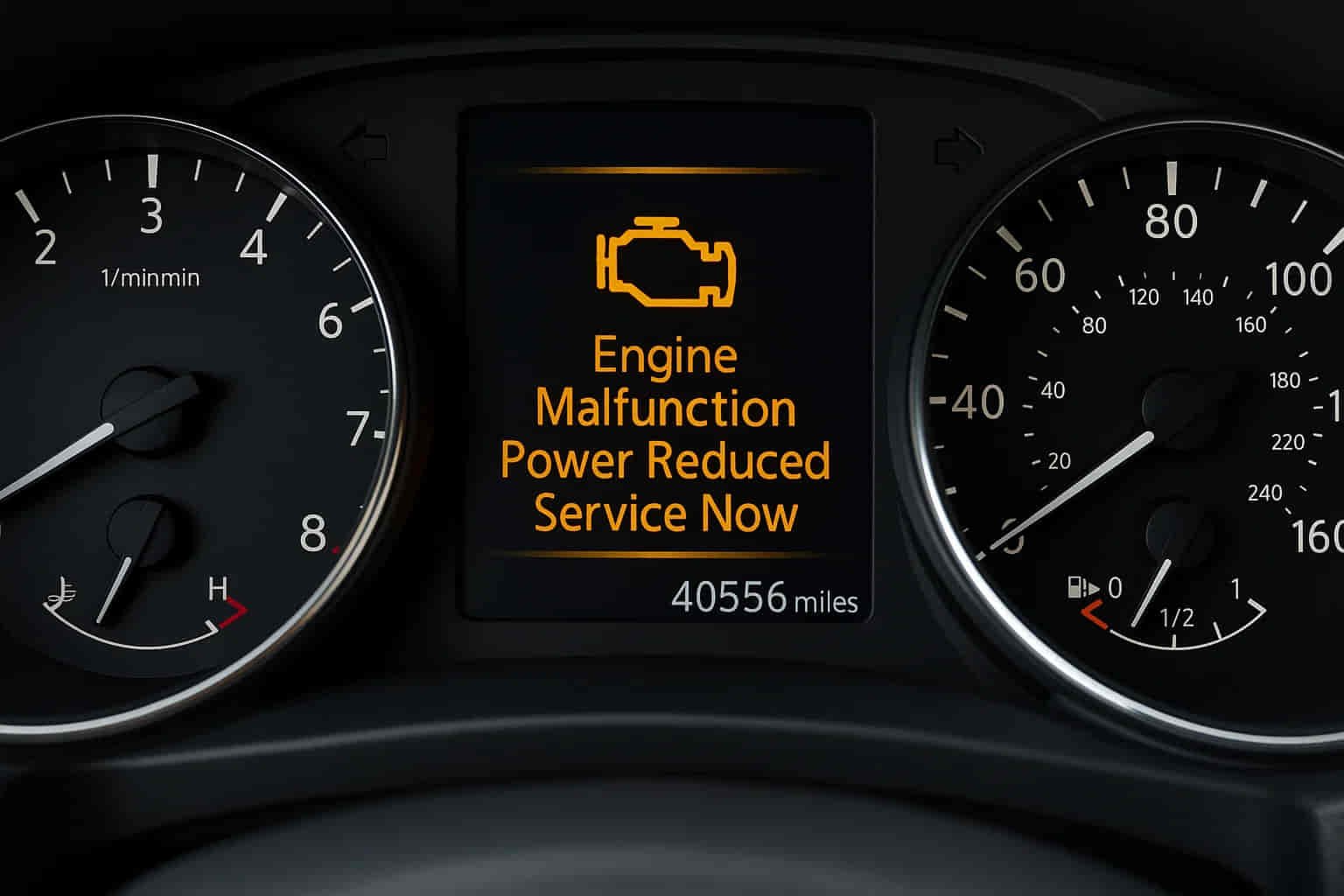If you’ve ever seen the warning message “Nissan Engine Malfunction Power Reduced Service Now” flash across your dashboard, you know the sudden mix of confusion and worry it brings. This alert isn’t just a random glitch—it’s your Nissan’s way of protecting itself from potential damage. Modern vehicles, from the Altima to the Rogue, rely on an intricate network of sensors and the Engine Control Unit (ECU) to manage performance, emissions, and safety. When any of these systems detect abnormal data—whether it’s a failing throttle body, low voltage, or disrupted airflow—the ECU steps in and reduces engine power to prevent further harm.
Understanding why this happens is essential, not only to fix the issue but to avoid costly repairs down the line. In this guide, we’ll dive deep into what this warning actually means, the most common causes behind it, how you can fix it effectively, and what the average repair cost looks like in 2025. Before you panic, let’s uncover what your Nissan is really trying to tell you—and how to get it back to full power safely.
What “Nissan Engine Malfunction Power Reduced Service Now” Actually Means
When your Nissan displays the “Engine Malfunction Power Reduced Service Now” message, it’s not a random error—it’s a signal that your car’s self-protection system has been activated. Modern Nissan vehicles are engineered with an advanced Engine Control Unit (ECU) that continuously monitors dozens of performance parameters. Every rotation of the crankshaft, every airflow measurement, and every voltage fluctuation is analyzed in real time. When one of these readings falls outside the normal operating range, the ECU interprets it as a potential risk to the engine or transmission.
To prevent serious damage, the ECU triggers a “limp mode”, which intentionally limits the car’s power output and throttle response. This is why you may feel your Nissan accelerate sluggishly or refuse to go above a certain RPM. While this mode feels frustrating, it’s essentially your vehicle’s built-in safety mechanism—an emergency state designed to allow you to drive to a safe location or nearby service center without worsening the damage.
This warning can appear due to various system imbalances—electrical, mechanical, or software-related—but the underlying logic remains the same: your Nissan is prioritizing protection over performance. Ignoring it or continuing to drive aggressively could escalate a minor sensor fault into an expensive engine or transmission repair. Understanding what triggers this alert is the first step toward restoring your car’s full power safely.
Common Causes of Power Reduced Warning in Nissan
The “Power Reduced Service Now” message doesn’t emerge without reason; it’s a precise response from the Nissan’s internal diagnostics. At the heart of it lies the communication between the ECU, the throttle body, and a network of sensors that interpret airflow, temperature, and fuel delivery. When any of these signals conflict, the ECU cuts engine power to prevent long-term wear.
One of the most frequent culprits is a failing throttle body. This component regulates how much air enters the engine. If carbon builds up or the throttle actuator sticks, the ECU immediately restricts performance to avoid uncontrolled acceleration. Similarly, a malfunctioning Mass Air Flow (MAF) sensor can send inaccurate readings about the volume of incoming air, forcing the ECU to adjust fuel injection improperly and triggering the warning message.
In some cases, the cause is electrical rather than mechanical. Loose wiring harnesses, corroded connectors, or a weak battery can disrupt voltage flow, creating inconsistent sensor readings. Even a temporary voltage drop during startup may convince the ECU that something is critically wrong.
Another potential source is a software glitch or outdated firmware in the ECU itself. Modern Nissans rely on algorithmic control, and a corrupted or outdated program can misread data patterns. Manufacturers occasionally release updates to correct these logic errors—something most drivers overlook.
Beyond the engine bay, the transmission control system also communicates with the ECU. A slipping gear or delayed shift may be detected as engine stress, triggering limp mode to safeguard the drivetrain. In this sense, the warning isn’t just about power—it’s about the overall harmony of the car’s electronic ecosystem.
While these causes vary, the underlying message remains consistent: the Power Reduced Service Now alert is not a random inconvenience but a safety-driven response. Treating it early, through diagnostics or professional inspection, prevents cascading failures and restores your Nissan’s performance before small issues grow into costly repairs.
How to Fix Nissan Engine Malfunction Power Reduced Service Now

Fixing the “Nissan Engine Malfunction Power Reduced Service Now” warning isn’t just about erasing a message—it’s about restoring balance in how your vehicle communicates internally. Every component in your Nissan, from the throttle body to the oxygen sensors, shares a data conversation with the ECU. When that communication breaks, power reduction is the ECU’s way of forcing silence until the issue is understood and resolved.
The most effective way to begin is by reading the car’s memory through an OBD2 diagnostic scan. This scan reveals specific error codes, each pointing toward the malfunctioning system—whether it’s airflow, ignition, or voltage-related. Once you have the codes, you can interpret them using Nissan’s technical documentation or through a professional mechanic who specializes in Nissan diagnostics. Many drivers skip this step and jump to repairs, but without identifying the root cause, the warning often reappears after a few drives.
In many cases, the fix can be surprisingly simple. A clean throttle body can restore air control precision; a new MAF sensor can recalibrate airflow measurements; even tightening or replacing corroded electrical connectors can eliminate false voltage readings that confuse the ECU. However, when deeper issues are involved—such as ECU logic faults or sensor synchronization errors—reprogramming or firmware updates at a certified Nissan service center become necessary. These updates correct miscommunication between the car’s modules and often clear persistent limp mode conditions instantly.
If the car’s behavior remains sluggish after addressing mechanical and electrical components, consider inspecting the battery and alternator. Inconsistent voltage is a silent trigger for multiple warning lights and can mimic more complex problems. Similarly, damaged wiring harnesses—often caused by heat, moisture, or rodents—can interrupt sensor feedback loops and must be tested for continuity.
Once the issue is resolved, clearing the warning message through the diagnostic tool resets the ECU’s protective mode. But resetting without solving the underlying problem is only temporary; the ECU will detect the same fault and re-enter limp mode. That’s why professional service verification is crucial, even if the car feels normal afterward.
In essence, fixing this warning is less about replacing random parts and more about rebuilding communication within your Nissan’s network. When every signal—from the throttle to the transmission—flows as designed, the ECU lifts the power restriction, allowing the engine to breathe freely again. By approaching the repair systematically instead of reactively, you ensure both short-term performance and long-term reliability.
Cost to Repair Nissan Power Reduced Service Now Issue (2025 Data)
When the “Power Reduced Service Now” message appears on your Nissan, repair costs can vary widely depending on the root cause. In 2025, the cost landscape for automotive diagnostics and part replacements has shifted due to inflation, software-based systems, and the growing complexity of electronic components. What used to be a simple mechanical tune-up is now often a mix of software calibration and precision sensor replacement.
For most drivers, the first step—diagnostics—usually costs between $80 and $150, depending on the service center and whether you choose a Nissan dealership or an independent garage. This fee typically covers a full OBD2 scan, ECU inspection, and a technician’s report outlining the fault codes.
If the issue lies in the throttle body, which regulates airflow into the engine, replacement costs range from $350 to $750, including labor. For a Mass Air Flow (MAF) sensor, the repair is slightly cheaper, averaging $200 to $400. ECU software updates or reprogramming—necessary when the warning is triggered by communication or firmware errors—cost around $150 to $300. Meanwhile, electrical repairs, such as fixing damaged wiring harnesses or corroded connectors, may fall between $100 and $250.
| Component / Service | Average Cost (USD) |
|---|---|
| Diagnostic Scan & ECU Check | $80–$150 |
| Throttle Body Replacement | $350–$750 |
| MAF Sensor Replacement | $200–$400 |
| ECU Reprogramming / Update | $150–$300 |
| Wiring / Connector Repair | $100–$250 |
It’s important to remember that these are averages, not fixed numbers. Regional labor rates, Nissan model variations, and even the age of your vehicle influence the final bill. In some cases, multiple faults coexist, especially if the limp mode was triggered by both sensor failure and voltage fluctuation, which can push costs above $1,000.
To minimize repair expenses, routine maintenance remains your best investment. Regularly cleaning the throttle body, ensuring stable battery voltage, and updating ECU software when available can prevent the Power Reduced Service Now warning from ever appearing again—saving both money and peace of mind.
How to Prevent Nissan Engine Malfunction Power Reduced Warning
Preventing the “Nissan Engine Malfunction Power Reduced Service Now” warning isn’t about luck—it’s about understanding how your vehicle’s digital ecosystem behaves and maintaining its equilibrium. Every Nissan relies on the synchronized operation of sensors, airflow systems, and the ECU’s decision-making algorithms. When one element drifts out of calibration, the system compensates silently until it no longer can. Preventive care ensures you never reach that breaking point.
Regular maintenance remains the most effective line of defense. Cleaning the throttle body and MAF sensor every 10,000 miles prevents the buildup of carbon and dust that can distort air readings. Equally important is maintaining a stable electrical environment: a weak or fluctuating battery voltage is one of the leading hidden causes behind false ECU alerts. Replacing an aging battery before it fails can save you from unexpected limp mode activations.
Keeping your vehicle’s ECU software updated is another overlooked yet essential step. Nissan periodically releases firmware updates to correct sensor logic or adjust performance thresholds. These updates often fix silent issues before they ever trigger a dashboard warning.
Environmental conditions also matter. Vehicles exposed to high humidity, salt, or dust are more prone to corrosion at connectors and grounding points—areas where preventive cleaning can make a huge difference.
Ultimately, preventing this warning is less about reacting to faults and more about creating consistency: consistent airflow, consistent voltage, consistent software. A Nissan that’s properly maintained won’t need to protect itself from you. By giving the ECU clean data and a stable environment, you ensure that the Power Reduced message remains something you’ll read about, not experience.
Conclusion
Seeing the “Nissan Engine Malfunction Power Reduced Service Now” warning can be unsettling, but it’s rarely a sign of catastrophic failure. Instead, it’s your car’s intelligent safeguard, stepping in to protect vital systems before something serious occurs. By understanding what this alert truly means, identifying its causes, and applying the right solutions, you’re not only restoring performance—you’re extending your Nissan’s lifespan.
Whether the issue stems from a misbehaving throttle body, a confused ECU, or a simple wiring inconsistency, the path to resolution is the same: accurate diagnosis, informed repair, and consistent maintenance. Ignoring the signal or resetting the ECU without addressing the root cause only postpones the inevitable.
As vehicles become increasingly digital, their reliability depends on data clarity and proactive care. So the next time that warning appears, see it not as an obstacle but as communication—a reminder that your Nissan is designed to protect itself, and you, from costly damage.
If the alert persists even after basic troubleshooting, scheduling a visit to a certified Nissan service center is the safest step. With the right attention, your engine will return to full strength—and that worrisome message will stay off your dashboard for good.

